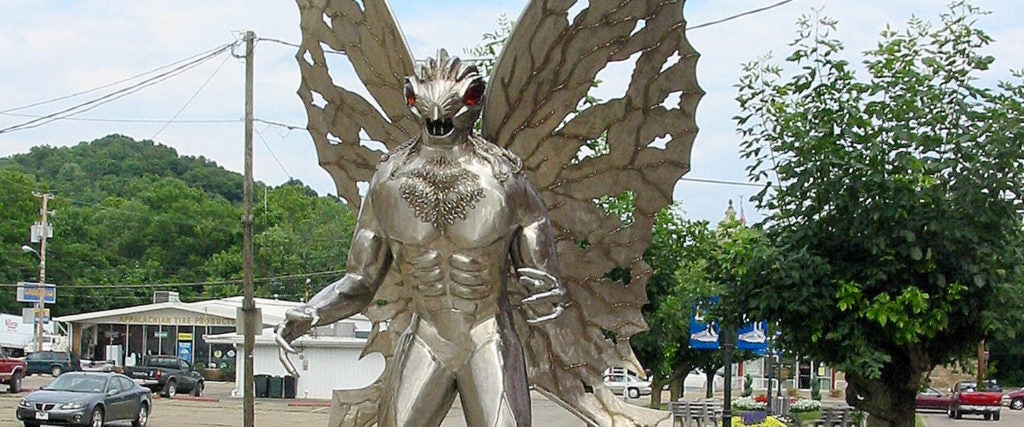Jay Sisson, a 30-year-old teacher who’s lived in West Virginia his entire life, makes a point to decorate his ninth-grade classroom with storied champions of the state’s past. The brave but often misunderstood heroes pinned to the walls represent a certain rugged individualism and perseverance that inspired him as a child, and he hopes they do the same for his students.
It’s also no coincidence that they’re all cryptids: Sasquatch, the Flatwoods Monster and — most importantly — Mothman.
“I want my students to love their home, to make it better despite the problems that exist here. I want them to see the good that exists here,” Sisson tells me. “I want our community to beat the odds, and the Mothman can embody that spirit because it’s ours. It’s a symbol for something bigger.”
Not surprisingly, then, Sisson has joined the growing chorus of West Virginians demanding the state replace all of its Confederate statues with Mothman statues instead.
“As a West Virginia native, I’d like to think we’re all spiritually connected to him,” explains Brenna, the 24-year-old who spurred on the movement with this viral tweet:
starting a petition to replace every confederate statue with mothman pic.twitter.com/jIv7Vt9VO2
— Brenna (@HumanBrennapede) June 8, 2020
— Rage of Devils (@RageofDevils) June 7, 2020
Tear down the Stonewall Jackson statue and replace it with another statue of West Virginia’s own mascot and son the Mothman. Repeat indefinitely until all Confederate monuments are replaced. This is the way. pic.twitter.com/MBzXZkRhAs
— Jay Sisson (@jaysisson) June 10, 2020
It’s not just some flash-in-the-pan shitpost, either. To many West Virginians, Mothman carries more significance than any Confederate general. In fact, the legend originated in the town of Point Pleasant, when locals spotted a “man-sized bird creature” prior to the 1967 Silver Bridge collapse that killed 46 people. “Mothman was blamed and retroactively seen as a bad omen that foreshadowed the disaster,” Brenna explains. “From there, the story of the Mothman spread across the country and became an urban legend of sorts.”
As Mothman continued to appear around major disasters (e.g., the 1999 Russian apartment bombings) and attracted Hollywood interest (e.g., The Mothman Prophecies, which starred Richard Gere and Laura Linney), West Virginians officially accepted the winged giant into their hearts. Point Pleasant held the first Mothman Festival in 2002, unveiled a 12-foot metallic Mothman statue in 2003 and opened the Mothman Museum and Research Center in 2005. And now, in 2020, they’re advocating for the cryptid to replace all nine Confederate statues in the state.
“These monuments aren’t ‘celebrating history’; they were specifically created to intimidate Black Americans,” Brenna says. “Statues aren’t needed to ‘remember the past’ when so many are still experiencing the repercussions today. Therefore, all monuments honoring the racist and oppressive history of the Confederacy should be removed. And who better to replace them than the Mothman?”
Reasons why mothman is better than the confederate statues:
1. Not racist
2. Not explicitly a symbol of white supremacy
3. Not a symbol of slavery
…
1007. Mothman has a thicker ass than any confederate general.— The Problem Clown (@mecasloth) June 8, 2020
here have a mothman fancam pic.twitter.com/TkXbbf3UBM
— heather ⎊ ? (@schwifts) June 12, 2020
“We have certain stories, oddities and bizarre pockets of the state that are unique to our region, and we find a sense of comfort in sharing these things together,” Sisson adds. “I don’t have a full explanation as to why, but it probably has something to do with the fact that we live in a state with a small population and one that’s suffered years of economic depression and population loss. These circumstances have bonded our population, especially the younger generation, very tightly together.”
Mothman is literally an icon to all the queers in West Virginia. I'm not even joking.
(Ps: look up what the statue looks like from behind)
— Go Trig Boy (@2ndbaseboy) June 9, 2020
To that end, 22-year-old Gray created a Mothman bot account on Twitter that now boasts more than 24,000 followers. He says the Babadook-esque appreciation for Mothman might come from a shared sense of “feeling othered or isolated.” Plus, he explains, “in a lot of depictions he looks so soft and furry you can’t help but think of him as a friend who would protect you from all kinds of terrible people.”
Mothman is real and he's 50% moth, 50% man, 100% boyfriend material
— mothman (@mothmanbot) June 11, 2020
Or as Brenna puts it more bluntly, “According to the statue, he has a six-pack and an objectively good ass. Unfortunately, I haven’t been so lucky to have seen him in real life, so for now, my ‘I Sucked the Mothman’s D*ck in Point Pleasant, WV’ graphic tee will have to do.”

